NSG 3370 STUDY QUESTIONS & ANSWER| 2022 UPDATE 100 % CORRECT
Document Content and Description Below
1. During pregnancy, dyspnea accompanied by increased respiratory rate, cough, rales, or respiratory distress raises concerns of: peripartum cardiomyopathy Explanation: Dyspnea accompanied by incr... eased respiratory rate, cough, rales, or respiratory distress raises concerns of possible infection, asthma, pulmonary embolus, or peripartum cardiomyopathy. 2. The middle section of the thoracic cavity containing the esophagus, trachea, heart, and great vessels is the: mediastinum Explanation: The middle section of the thoracic cavity containing the esophagus, trachea, heart, and great vessels is the mediastinum. The right and left pleural cavities, are on either side of the mediastinum and those contain the lungs. The visceral pleura encloses the lung. The pericardium surrounds the heart. 3. A patient is unable to identify the smell of an orange. This inability could reflect an abnormality in cranial nerves: CN I Explanation: Cranial Nerve I is the olfactory nerve responsible for the sense of smell. To test the sense of smell, the examiner presents the patient with familiar and nonirritating odors. A person should normally perceive odor on each side and correctly identify the source. Cranial Nerves II and III assess vision and pupillary reaction. Cranial Nerve VIII tests the hearing and balance. 4. A transient ischemic attack is: a transient episode of neurologic dysfunction by focal brain, spinal cord, or retinal ischemia, without acute infarction Explanation: TIA is now defined as “a transient episode of neurological dysfunction caused by focal brain, spinal cord, or retinal ischemia, without acute infarction.” Ischemic stroke is “an infarction of central nervous system tissue” that may be symptomatic or silent. The other terms are not related to the new definitions. 5. The term asteatosis refers to: skin that is dry, flaky, rough, and often itchy Explanation: Physiologic changes of aging include loss of elastic turgor, and wrinkling. Skin that appears dry, flaky, rough, and itchy is termed asteatosis. Sun exposure can cause damage to the skin resembling an appearance as weather beaten, thickened, yellowed, and deeply furrowed. Seborrheic keratosis appear as raised, yellowish lesions that feel greasy, velvety, or warty. Painful vesicular lesions in a dermatomal distribution may suggest herpes zoster. 6. An enlarged liver with a smooth tender edge may suggest: right-sided heart failure. Explanation: An enlarged liver with a smooth, tender edge suggests inflammation, as in hepatitis, or venous congestion, as in right-sided heart failure. Cirrhosis, hematochromatosis (increased amount of iron in the blood), and lymphoma produce an enlarged liver with a firm, nontender edge. An enlarged liver that is firm or hard and has an irregular edge or surface suggests hepatocellular carcinoma. 7. New onset hypertension with proteinuria or end-organ damage is: preeclampsia Explanation: Chronic hypertension occurs when systolic BP (SBP) >140 mm Hg or diastolic BP (DBP) >90 mm Hg documented prior to pregnancy, before 20 weeks, or beyond 12 weeks postpartum. Gestational hypertension refers to elevated blood pressure detected after 20 weeks gestation in the absence of proteinuria. Pre-eclampsia occurs in a woman who was previously normotensive but now has new onset hypertension with either proteinuria or end-organ damage. Primary hypertension, formerly known as essential hypertension, is a disorder which is associated with elevated blood pressure and an unidentifiable cause. 8. The psoas muscle group and muscles of the abdominal wall assist with: flexion Explanation: The psoas muscle group and muscles of the abdominal wall assist with flexion. The deep intrinsic muscles of the back assist with extension. The abdominal muscles and intrinsic muscles of the back assist with rotation. Lateral bending uses the abdominal muscles and intrinsic muscles of the back. 9. "Preterm small for gestational age" (SGA) infants are prone to: hypocalcemia Explanation: "Preterm appropriate for gestational age" (AGA) infants are prone to respiratory distress syndrome, apnea, patent ductus arteriosus with left-to-right shunt, and infection. "Preterm small for gestational age" (SGA) infants are more likely to experience asphyxia, hypoglycemia, and hypocalcemia. 10. Swelling noted 1-2 inches below the knee joint and on the medial surface of the knee would be suggestive of: anserine bursitis Explanation: Swelling 1-2 inches below the knee joint and on the medial surface would be suggestive of anserine bursitis. Swelling over the tibial tubercle suggests infrapatellar bursitis. Swelling over the patella suggests prepatellar bursitis. Semimembranous bursitis would be suggested by swelling on the posterior and medial surface of the knee. 11. A patient states that the only way he can sleep at night is to use several pillows or to sleep upright in a recliner. This sleep pattern is most consistent with: obstructive lung disease Explanation: With obstructive lung disease, the patient experiences orthopnea, dyspnea that occurs when the patient lies down but improves with sitting. Therefore, the patient would use several pillows or sleep upright in a recliner. Orthopnea is seen in obstructive lung disease, mitral stenosis, and heart failure. Paroxysmal nocturnal dyspnea describe episodes of sudden dyspnea that cause the patient to awaken from sleep where the patient must sit up, walk, or stand for it to resolve. Coughing and wheezing may also occur. Angina pectoris commonly creates chest pain or shortness of breath. Jugular venous pressure reflects right atrial pressure and volume status. In cases of cardiac or pulmonary dysfunction, jugular venous pressures usually raise. 12. A positive obturator sign would elicit pain in the: right hypogastric area Explanation: Assessment of the obturator sign is performed by flexing. By flexing the patient's right thigh at the hip with the knees bent, rotating the leg internally at the hip. If this causes increased pain in the right epigastric area, then the obturator sign is positive. Hypogastric pain occurs as the obturator muscle rubs an inflamed appendix. 13. The lateral bone that serves as a strut between the scapula and the sternum is known as the: clavicle Explanation: The lateral bone that serves as a strut between the scapula and the sternum is known as the clavicle. The humerus is the long bone of the upper arm. The acromion process is an extension of the spine of the scapula and located at the highest point of the shoulder. The thick curved extension of the superior border of the scapula is referred to as the coracoid process. 14. When examining the foot of a patient, the nurse practitioner notes focal heel tenderness on palpation of the plantar fascia. This could be suggestive of: plantar fasciitis Explanation: Focal heel tenderness on palpation of the plantar fascia suggests plantar fasciitis. Bone spurs may be present on the calcaneus as bony projections and may cause numbness, tenderness, or pain. Localized tenderness on examination of the ankle joint could be suggestive of arthritis, infection of the ankle, or ligamentous injury. Tenderness along the posterior medial malleolus suggests posterior tibial tendinitis. 15. When examining the conjunctiva and sclera, have the patient look upward and then: depress both lower lids with your thumbs, exposing the sclera and conjunctiva Explanation: When examining the conjunctiva and the sclera, the best way to expose these structures is to have the patient look upward and depress both lower lids with your thumbs. Covering one eye while visualizing the other eyes checks for visual acuity. Observing for excessive tearing or dryness assesses the lacrimal apparatus. Checking the position of the lids may identify variations and abnormalities in the eyelids. 16. The groove of the metacarpophalangeal joint can be palpated by having the patient: flex his hand Explanation: The groove of the metacarpophalangeal joints can be palpated by having the patient flex his hand. 17. A patient complains of shooting pains below the knee radiating into the lateral leg and calf. This type of low back pain is referred to as: radicular low back pain Explanation: Radicular low back pain, or sciatica, presents with shooting pains below the knee, into the lateral leg or posterior calf. It may be accompanied by paresthesias and/or weakness in the affected leg. Mechanical low back pain often arises from muscle and ligament injuries (~70%) or age-related intervertebral disc or facet disease. Common symptoms include aching pain in the lumbosacral area that radiates to the upper leg. Common risk factors include heavy lifting, poor conditioning, and obesity. Lumbar spinal stenosis or "pseudoclaudication" refers to pain in the back or legs with walking that improves with rest, lumbar flexion, or both. 18. When assessing a 3-month-old for developmental dysplasia of the hips (DDH), which one of the following symptoms would be suspicious of dysplasia? Limitation of abduction of the affected extremity, shortening of the femur and positive Ortolani's sign Explanation: Developmental dysplasia of the hips (DDH) presents with limitation of abduction, shortening of the extremity, as the head of the femur does not fit into the acetabulum, and a positive Ortolani's (it clicks when maneuvered). DDH presents with asymmetry of the gluteal folds. 19. A patient presents with right upper quadrant and upper abdominal pain. Acute cholecystitis is suspected because the pain radiates to the: right scapula area Explanation: Acute cholecystitis presents with right upper quadrant and upper abdominal pain radiating to the right scapular area. It is usually steady and aching. Pain in the epigastric area could be associated with peptic ulcer or dyspepsia. Cancer of the stomach can present with epigastric pain. Acute mechanical colon obstruction presents with pain in the lower abdomen. 20. The preauricular lymph node is located: in front of the ear Explanation: The preauricular lymph nodes are located in front of the ear. The tonsillar lymph nodes are at the angle of the mandible. The occipital lymph nodes are located at the base of the skull posteriorly. The posterior auricular nodes are superficial to the mastoid process. 21. Cessation of the menses for 12 months is termed: menopause Explanation: Menopause is defined as cessation of menses for 12 months, progressing through several stages of erratic cyclical bleeding. Oligomenorrhea is infrequent bleeding with menses occurring greater than 35-day intervals, or 4-9 menstrual cycles per year. Menorrhagia refers to excessive or prolonged menstrual flow occurring at regular intervals. Metrorrhagia refers to intermenstrual bleeding. 22. The gastrocnemius and soleus muscles are located by palpating the: posterior surface of the lower leg Explanation: The gastrocnemius and soleus muscles are located by palpating the posterior surface of the lower leg. 23. One cause of nasal septum perforation may be: intranasal use of cocaine Explanation: Perforation of the nasal septum could be caused by trauma, surgery, and intranasal use of cocaine or amphetamines. Nasal polyps obstruct air flow but there is no relationship to nasal septum perforation. Cystic fibrosis or chronic sinusitis are not associated with nasal perforation. 24. Tenderness in the costovertebral angles may signify: pyelonephritis Explanation: Because the kidney lies directly under the costovertebral angle, tenderness over this area would be related to renal issues such as renal stones or pyelonephritis. 25. A patient presents with an altered level of consciousness. He/she is considered in a stuporous state if he/she: arouses from sleep after exposure to painful stimuli, exhibits slow verbal responses, and easily lapses into an unresponsive state Explanation: A stuporous patient arouses from sleep after exposure to painful stimuli, verbal responses are slow, and lapses into an unresponsive state. A lethargic patient appears drowsy but opens the eyes, looks at the examiners, answers the questions, and then falls asleep. An obtunded patient opens the eyes and looks at the examiner, but responds slowly and is somewhat confused. A comatose patient remains unarousable with eyes closed. There is no evident response to inner need or external stimuli. 26. A flat affect can be an identifiable finding in an older adult who has: depression Explanation: Flat affect occurs in depression, Parkinson’s disease, or Alzheimer’s disease. 27. Pain and crepitus over the patella suggests: roughening of the patellar undersurface Explanation: Pain and crepitus over the patella suggests roughening of the patellar undersurface that articulates with the femur. Tenderness over the patellar tendon or inability to extend the knee suggests a partial or complete tear of the patellar tendon. A degenerative patella produces pain with compression and patellar movement during quadriceps contraction. Swelling above and adjacent to the patella suggest synovial thickening or effusion of the knee joint. 28. A child with a heart murmur audible at the lower left sternal border would be suggestive of: ventricular septal defect Explanation: This type murmur is not considered a normal finding in children. The murmur associated with a ventricular septal defect is audible at the lower left sternal border. A child with a heart murmur located at the midsternum or upper right sternal border and associated with a click could be suggestive of aortic valve stenosis. A murmur located at the upper left sternal border with a prominent ejection click in early systole could be suggestive of pulmonary valve stenosis. 29. In order to visualize the opening of Stensen's duct, examine the: buccal mucosa opposite the second molar Explanation: The largest salivary gland is the parotid gland and it lies within the cheeks in front of the ear extending from the zygomatic arch down to the angle of the jaw. Its duct, Stensen's duct, runs forward to an opening on the buccal mucosa opposite the second molar. If blood comes out through Stensen's duct when it is palpated, this could suggest parotid cancer. If pus is expelled, it suggests suppurative parotitis. With mumps, the orifice of the Stensen duct appears erythematous and enlarged. The submandibular gland is the size of a walnut. It lies beneath the mandible at the angle of the jaw. Wharton's duct runs up and forward to the floor of the mouth and opens at either side of the frenulum. The smallest, the almond-shaped sublingual gland, lies within the floor of the mouth under the tongue. It has many small openings along the sublingual fold under the tongue. 30. Hyperalgesia refers to: increased sensitivity to pain Explanation: Analgesia refers to absence of pain sensation; hypalgesia to decreased sensitivity to pain; hyperalgesia to increased sensitivity; and anesthesia to absence of touch sensation. 31. The part of the brain that maintains homeostasis is the: hypothalamus Explanation: The hypothalamus maintains homeostasis and regulates temperature, heart rate, and blood pressure. The hypothalamus affects the endocrine system and governs emotional behaviors such as anger and sexual drive. Hormones secreted in the hypothalamus act directly on the pituitary gland. 32. A 80 year old male visits the nurse practitioner for an annual well exam. History reveals two falls in the prior 12 months and difficulty with balance. The next step the nurse practitioner should take is: obtain cognitive and functional assessment Explanation: High-risk older adults, namely those with a single fall in the past 12 months with abnormal gait and balance and those with two or more falls in the prior 12 months, an acute fall, and/or difficulties with gait and balance, require further assessment to determine the reasons for the falls. Obtaining relevant medical history, physical exam, cognitive and functional assessment and determining multifactorial fall risks are essential to the preventing future falls. 33. Which one of the following symptoms would be seen in a 39 week gestational age patient who was suspected of having HELLP syndrome? Vomiting, flu - like symptoms, and platelet count < 100,000 Explanation: HELLP syndrome is a life-threatening pregnancy complication usually considered to be a variant of pre-eclampsia. Both conditions usually occur during the later stages of pregnancy, or sometimes after childbirth. Its characteristics: H (hemolysis), EL (elevated liver enzymes) and LP (low platelet count). 34. Flexion contracture of the knee suggests hamstring tightness or: limb paralysis Explanation: Flexion contracture (inability to extend fully) is seen in hamstring tightness or limb paralysis. Swelling over the patella suggests prepatellar bursitis. Stumbling or "giving way" of the knee during the heel strike phase of gait suggests quadriceps weakness or abnormal patellar tracking. 35. A protrusion of the membranes that cover the spine and the spinal cord itself, through a defect in the bony encasement of the vertebral column is known as: a meningomyelocele Explanation: A meningomyelocele is defined as the protrusion of the membranes that cover the spine and the spinal cord itself, through a defect in the bony encasement of the vertebral column. A developmental congenital disorder caused by the incomplete closing of the embryonic neural tube is known as spina bifida. A protrusion of the spinal cord through a defect in the vertebral arch is referred to as a myelocele. An omphalocele is a type of abdominal wall defect in which the intestines, liver, and occasionally other organs remain outside of the abdomen in a sac. 36. Static stabilizers of the shoulder are referred to as those structures that are: bony structures of the shoulder girdle Explanation: Static stabilizers are incapable of movement and include the bony structures of the shoulder girdle, the labrum, the articular capsule, and the glenohumeral ligaments that add to joint stability. Dynamic stabilizers are capable of movement and include the SITS muscles of the rotator cuff (supraspinatus, infraspinatus, teres minor, and subscapularis). These muscles move the humerus and compress and stabilize the humeral head within the glenoid cavity. 37. With inspection of the male infant's penis, the urethral orifice appears on the dorsal surface of the glans. This finding is consistent with: epispadias Explanation: With inspection of the male infant's penis, the urethral orifice appears on the dorsal surface of the glans. This finding is consistent with epispadias. A chordee refers to the fixed downward bowing of the penis. With inspection of the male infant's penis, the urethral orifice appears on the ventral surface of the glans. This finding is consistent with hypospadias. Cryptorchidism is a term used to describe undescended testicles in a male. 38. The nurse practitioner should base a response to a parent's question about the prognosis of acute lymphoblastic leukemia (ALL) on which of the following statement: A majority of children go into remission and remain symptom free when treatment is completed Explanation: The majority of children diagnosed with the most common form of leukemia, acute lymphoblastic leukemia, go into remission and remain symptom free when treatment is complete and will have an 85% disease free survival rate. With the majority of children surviving 5 years or longer, it is inappropriate to refer to leukemia as a fatal disease. The research statement is true, but it does not address the parent's concern. About 95% of children achieve remission within the first month of chemotherapy. 39. To assess for strabismus in a child, use the: cover-uncover test Explanation: The cover-uncover test assesses coordination of eye muscle movement when one eye is covered. It is always assessed bilaterally. Strabismus is identified when the covered eye is found to deviate from its forward focus. Snellen eye chart assesses visual acuity; ophthalmoscope is used to visually assess the fundus of the eye. Pupillary reaction tests the ability of the eyes to react to light and accommodate. 40. While assessing the cranial nerves, the nurse practitioner touches the cornea lightly with a wisp of cotton. This maneuver assesses which cranial nerve? Cranial Nerve V (CN V) Explanation: Touching the cornea and assessing for a reflex assesses cranial nerve V. (sensory) 41. When examining the foot of a patient, the nurse practitioner notes tenderness of the posterior medial malleolus. This could be suggestive of: tibial tendinitis Explanation: Tenderness along the posterior medial malleolus suggests posterior tibial tendinitis. Bone spurs may be present on the calcaneus as bony projections and may cause numbness, tenderness, or pain. Localized tenderness on examination of the ankle joint could be suggestive of arthritis, infection of the ankle, or ligamentous injury. Focal heel tenderness on palpation of the plantar fascia suggests plantar fasciitis. 42. Upon examination of the vagina, the entire anterior vaginal wall, together with the bladder and urethra create a bulge. This condition is most consistent with a: cystourethrocele Explanation: When the entire anterior vaginal wall, together with the bladder and urethra, is involved in the bulge, a cystourethrocele is present. A cystocele is a bulge of the upper two-thirds of the anterior vaginal wall and the bladder above it. It results from weakened supporting tissues. A prolapsed urethral mucosa forms a swollen red ring around the urethral meatus. A urethral caruncle is a small, red, benign tumor visible at the posterior part of the urethral meatus. 43. A 3 year-old presents with a history of fever and cough over the past 24 hours. Findings on exam reveal: temperature of 102°F, apical heart rate of 157 beats/minute, and respiratory rate of 40 breaths/minute. Tachypnea in this child is most likely related to the child's febrile state Explanation: In children, heart and respiratory rates will increase with fever. For every degree of fever the respiratory rate will increase 3-4 breaths/minutes and the heart rate will increase 8-10 beats/minute. 44. A female patient presents with a profuse, yellowish, green vaginal discharge that is malodorous. This vaginal discharge is most consistent with: Trichomonal vaginitis Explanation: Trichomonas vaginalis causes trichomonal vaginitis. Presenting symptoms include a profuse, yellowish, green vaginal discharge that is malodorous. Candidal vaginitis produces a white and curd-like thin discharge that is rarely malodorous. With bacterial vaginosis, the discharge can be gray or white, thin, malodorous (fishy), and not usually profuse. The discharge associated with gonorrhea is usually thick and bloody. 45. When assessing plantar reflexes, the nurse practitioner strokes the lateral aspect of the sole from the heel to the ball of the right foot. Absence of movement of the big toe is noted. This finding could be suggestive of a pathologic lesion in which segmented level of the spine? Lumbar 5 and Sacral 1 Explanation: Superficial (cutaneous) reflexes and their corresponding spinal segments include the following: Abdominal reflexes: upper thoracic 8, 9, 10 and lower thoracic 10, 11, 12; Plantar: lumbar 5 and sacral 1; and Anal: sacral 2, 3, 4. 46. Which disorder of the eye can be detected with the cover-uncover and the Hirschberg test? Strabismus Explanation: Strabismus is misalignment of the eyes and can be assessed using the cover-uncover teats and the Hirschberg test (corneal light reflex). With the cover-uncover test, eye muscle weakness is seen as eye deviation when the eye is uncovered. With Hirschberg's test, an asymmetric light reflex indicates a deviation. Cataracts are visualized by a cloudiness or opacity in the lens. Conjunctivitis is diagnosed by observation of a discharge from the eyes and erythema of the conjunctiva. Amblyopia is diagnosed by visual assessment and testing by an optometrist or ophthalmologist. 47. If fetal movement cannot be perceived after 24 weeks gestation, all of the following may be considered except: normal finding Explanation: If fetal movement cannot be perceived after 24 weeks, consider error in calculating gestational age, fetal death or severe morbidity, or false pregnancy. Confirm fetal health and gestational age with an ultrasound. 48. To palpate an indirect inguinal hernia in a woman, have her stand and palpate in the labia majora and: palpate upward to just lateral to the pubic tubercles Explanation: To palpate an indirect inguinal hernia in a woman, have her stand and palpate in the labia majora and upward to just lateral to the pubic tubercles. 49. Bilateral exophthalmos suggests: Grave's disease Explanation: Exophthalmos is an abnormal protrusion of the eye. When it presents bilaterally, it is suggestive of Grave's disease, a form of hyperthyroidism. Unilateral exophthalmos may be due to Grave's disease or to a tumor or inflammation of the orbit. Hashimoto's thyroiditis, hypothyroidism, and goiter do not present with exophthalmos. 50. If regular uterine contractions occur prior to 37 weeks gestation, this could be: preterm labor Explanation: Before 37 weeks, regular uterine contractions with or without pain and bleeding are abnormal, suggesting preterm labor. 51. A form of aphasia in which the person has difficulty speaking and understanding words and is unable to read or write is termed: global aphasia Explanation: With global aphasia, the person has difficulty speaking and understanding words and is unable to read or write. In Broca's aphasia, speech is confluent, slow, with few words and laborious effort. Inflection and articulation are impaired but words are meaningful, with nouns, transitive verbs, and important adjectives. Small grammatical words are often dropped. With anomic aphasia, the person has word-finding difficulties and because of the difficulties, the person struggles to find the right words for speaking and writing. With Wernicke's aphasia, speech is fluent, often rapid, voluble, and effortless. Inflection and articulation are good, but sentences lack meaning and words are malformed (paraphasias) or invented (neologisms). Speech may be totally incomprehensible. 52. When examining the knee, a fluid wave on the medial side between the patella and the femur is noted. This positive sign for effusion of the knee is known as the: bulge sign Explanation: When examining the knee, a fluid wave on the medial side between the patella and the femur is noted. This positive sign for effusion is known as the bulge sign. A positive balloon sign in the knee is the presence of a palpable fluid wave with a returning fluid wave into suprapatellar pouch. Balloting the patella occurs by compressing the suprapatellar pouch and pushing the patella sharply against the femur, causing fluid to return to the suprapatellar pouch. McMurray's test checks for tears in the medial menis 53. Which nerve runs from the spine through the neck, the axilla, and into the arm? Brachial plexus Explanation: The brachial plexus is a network of nerve fibers that runs from the spine through the neck, the axilla, and into the arm. This network of nerves passes through the cervico-axillary canal to reach the axilla and innervates brachium (upper arm), antebrachium (forearm), and hand. The radial nerve originates in the axilla and travels down the arm in a shallow depression (radial groove) on the surface of the humerus. The median nerve is located on the ventral forearm and is just medial to the brachial artery in the antecubital fossa. The ulnar nerve runs posteriorly in the ulnar groove between the medial epicondyle and the olecranon process. 54. When upper motor neuron systems are damaged below the crossover of its tracts in the medulla, motor impairment develops on the same side. This term is: ipsilateral Explanation: When upper motor neuron systems are damaged above the crossover of its tracts in the medulla, motor impairment develops on the opposite side. This term is contralateral. In damage below the crossover, motor impairment would occur on the same side or ipsilateral side. Superficial refers to the outer surface of something. Intermediate is a term used to denote something between two other structures. 55. Symptoms of orthostatic hypotension include all of the following except: syncope: unsteadiness: visual blurring: respiratory rate greater than 30. Explanation: Orthostatic hypotension occurs in 20% of older adults and in up to 50% of frail nursing home residents, especially when they first arise in the morning. Symptoms include lightheadedness, weakness, unsteadiness, visual blurring, and in 20% to 30% of patients, syncope. 56. What is the earliest recognizable clinical manifestation(s) of cystic fibrosis in a child? Clubbing, frequent respiratory infections, and rectal prolapse Explanation: Cystic fibrosis is one of the most common genetic disorders in Caucasian children in the United States and is usually diagnosed at an early age. However, if it is not diagnosed in infancy, some of the symptoms seen in children include: not growing or gaining weight appropriately, frequent lung infections, persistent cough, and wheezing. Other symptoms may also develop in childhood such as: clubbing, rectal prolapse, and polyps in the nose or sinuses. The other choices are not seen in cystic fibrosis. 57. The most effective method to use when assessing visual acuity in young children, is the: E chart. Explanation: The E chart and Snellen charts assess visual acuity but for the young child, but the E chart is more appropriate. The child can tell the examiner which direction the E is pointing. The Snellen test requires that the child be able to identify letters of the alphabet. The most effective method to use when assessing conjugate gaze in young children, is the use of the cover-uncover test and the corneal light reflex test. The Ishihara chart assesses color blindness. 58. An adolescent visits the nurse practitioner for a sports participation physical. The nurse practitioner instructs the adolescent to hold his arms against his lateral upper legs against resistance. This maneuver assesses for: strength of the deltoid muscle Explanation: This maneuver assesses strength of the deltoid muscle. 59. Ptosis of the left eye would be suggestive of damage to which cranial nerve? Cranial Nerve III (CN III) Explanation: Ptosis of the left eye would be suggestive of 3rd nerve palsy (CN III)-Oculomotor nerve. 60. When performing the first Leopold maneuver on a pregnant woman, if the fetal buttocks and head are not easily palpated at the fundus, the fetus is said to be in: [Show More]
Last updated: 1 year ago
Preview 1 out of 71 pages

Reviews( 0 )
Recommended For You
*NURSING> EXAM > NR565 / NR565 Advanced Pharmacology Fundamentals Midterm / Final Exam| 240 Questions and 100 % Correct Answers. Chamberlain College (All)
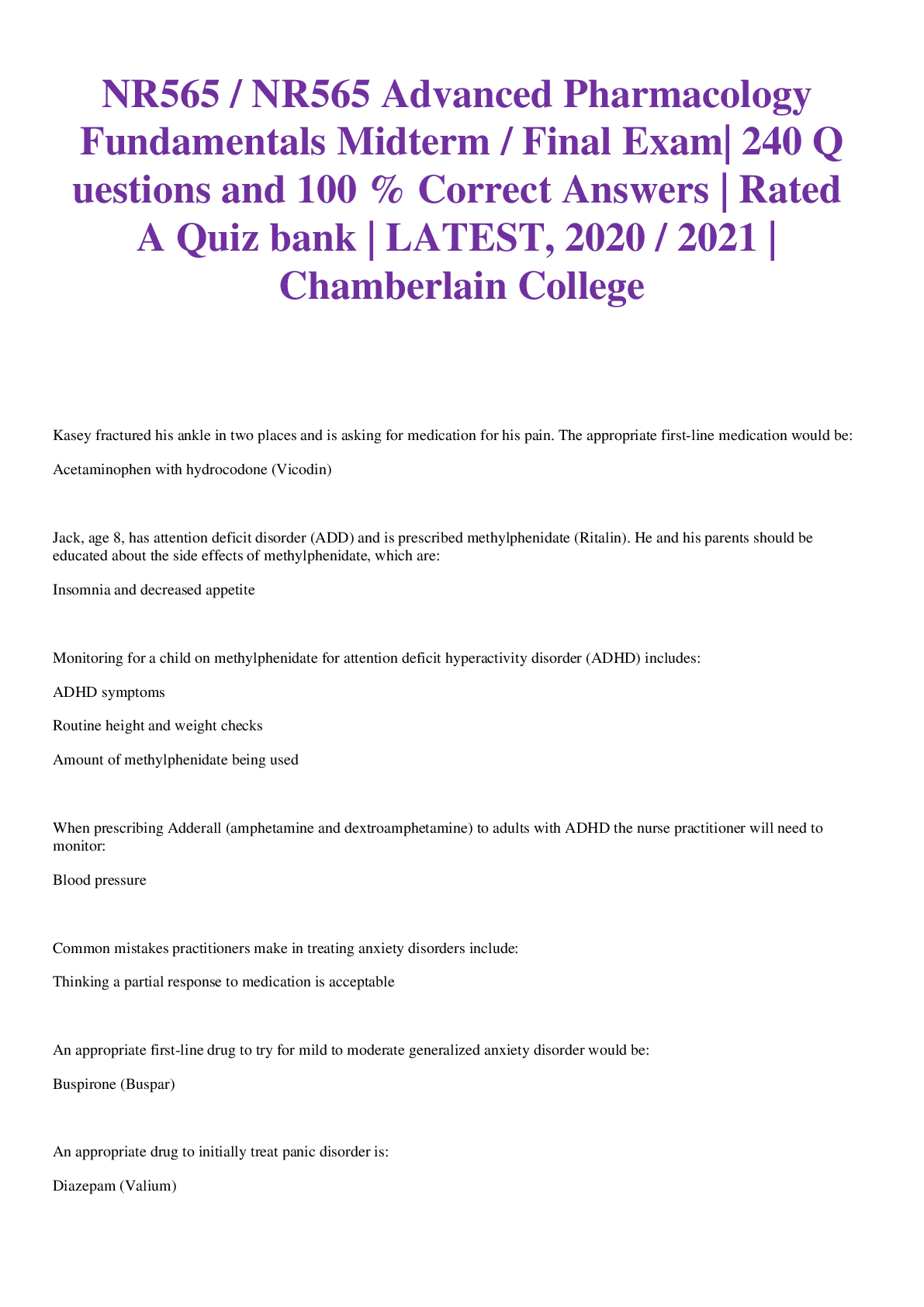
NR565 / NR565 Advanced Pharmacology Fundamentals Midterm / Final Exam| 240 Questions and 100 % Correct Answers. Chamberlain College
NR565 / NR565 Advanced Pharmacology Fundamentals Midterm / Final Exam| 240 Questions and 100 % Correct Answers | Rated A Quiz bank | LATEST, 2020 / 2021 | Chamberlain College 1. Kasey fractured...
By nurse_steph , Uploaded: Nov 21, 2020
$15
*NURSING> EXAM > NR 508 / NR508 Advanced Pharmacology Final Exam | Questions and Answers with Rationale | Latest 2020 / 2021 | 100 % Correct | Chamberlain College (All)
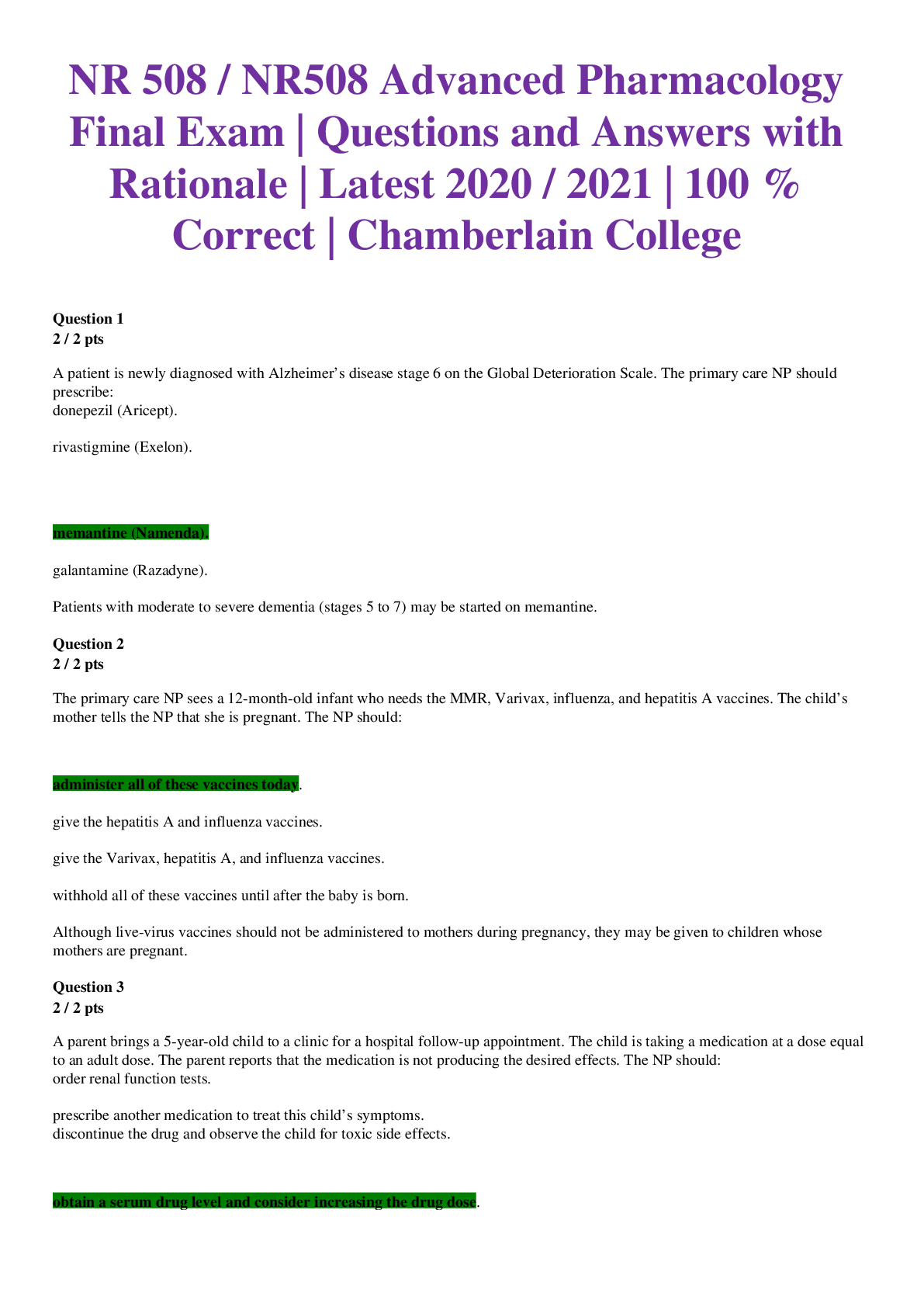
NR 508 / NR508 Advanced Pharmacology Final Exam | Questions and Answers with Rationale | Latest 2020 / 2021 | 100 % Correct | Chamberlain College
NR 508 / NR508 Advanced Pharmacology Final Exam | Questions and Answers with Rationale | Latest 2020 / 2021 | 100 % Correct | Chamberlain College Question 1 2 / 2 pts A patient is newly diagnose...
By nurse_steph , Uploaded: Dec 13, 2020
$14
*NURSING> EXAM > CPN Study Questions 1-100 Exam 100 Questions with Verified Answers,100% CORRECT (All)
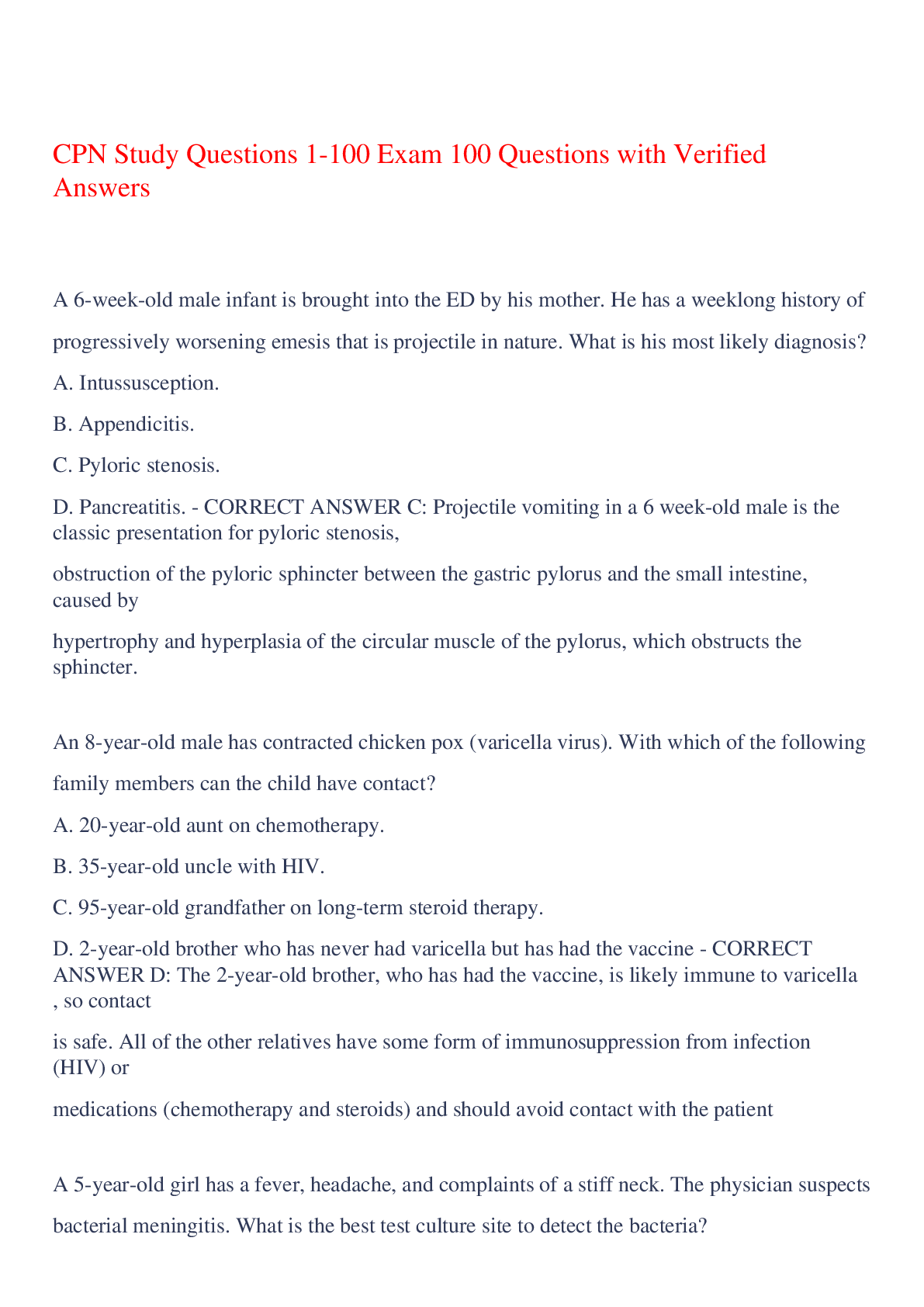
CPN Study Questions 1-100 Exam 100 Questions with Verified Answers,100% CORRECT
CPN Study Questions 1-100 Exam 100 Questions with Verified Answers A 6-week-old male infant is brought into the ED by his mother. He has a weeklong history of progressively worsening emesis that...
By securegrades , Uploaded: Nov 05, 2023
$9.5
Pharmacology> EXAM > ATI PHARMACOLOGY FINAL EXAM WITH 100 QUESTIONS AND 100% CORRECT ANSWERS (All)
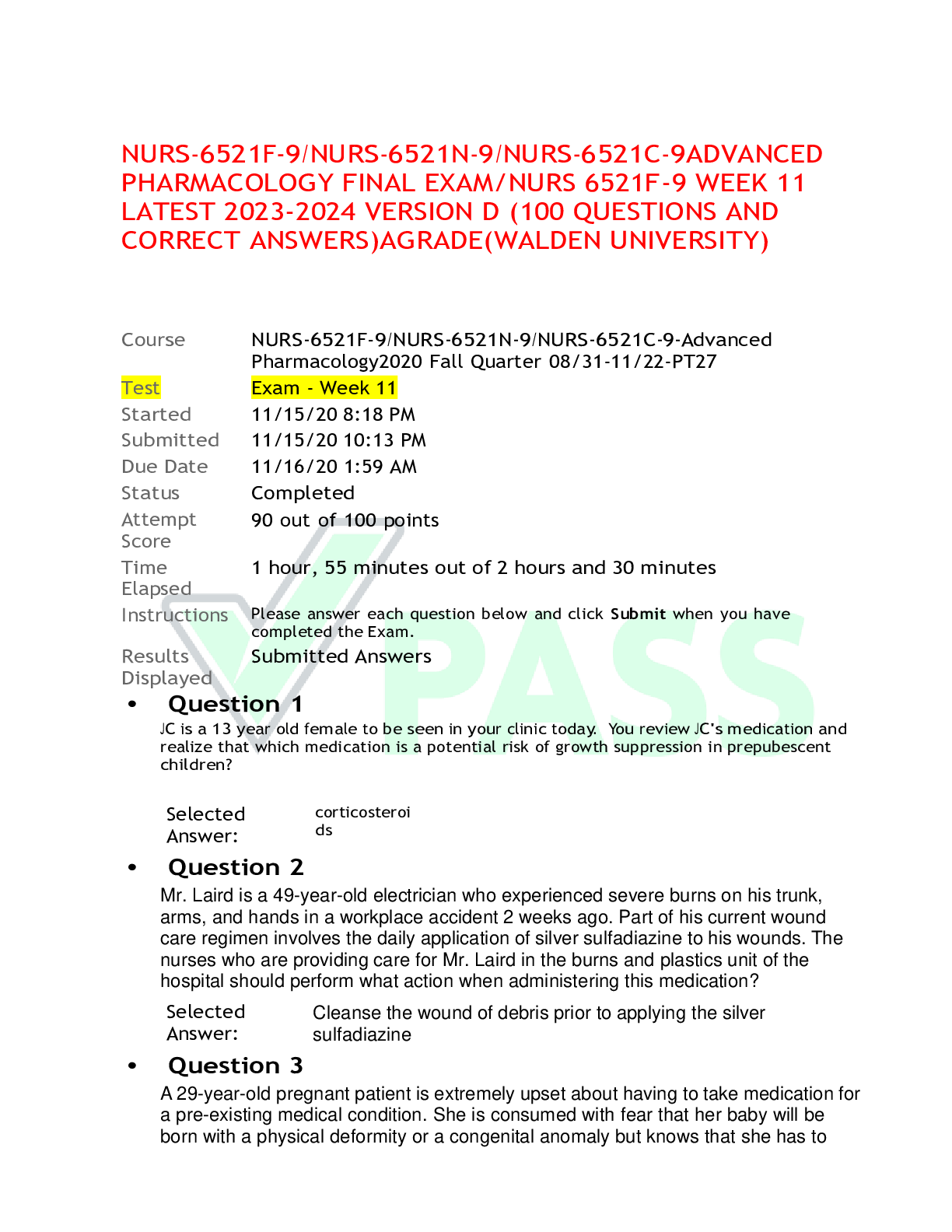
ATI PHARMACOLOGY FINAL EXAM WITH 100 QUESTIONS AND 100% CORRECT ANSWERS
1.JC is a 13 year old female to be seen in your clinic today. You review JC's medication and realize that which medication is a potential risk of growth suppression in prepubescent children? Sel...
By Excellentpass , Uploaded: Feb 02, 2022
$12
Pharmacology> EXAM > NURS 6521N ADVANCED PHARMACOLOGY FINAL EXAM WITH 100 QUESTION AND 100% CORRECT ANSWERS (All)
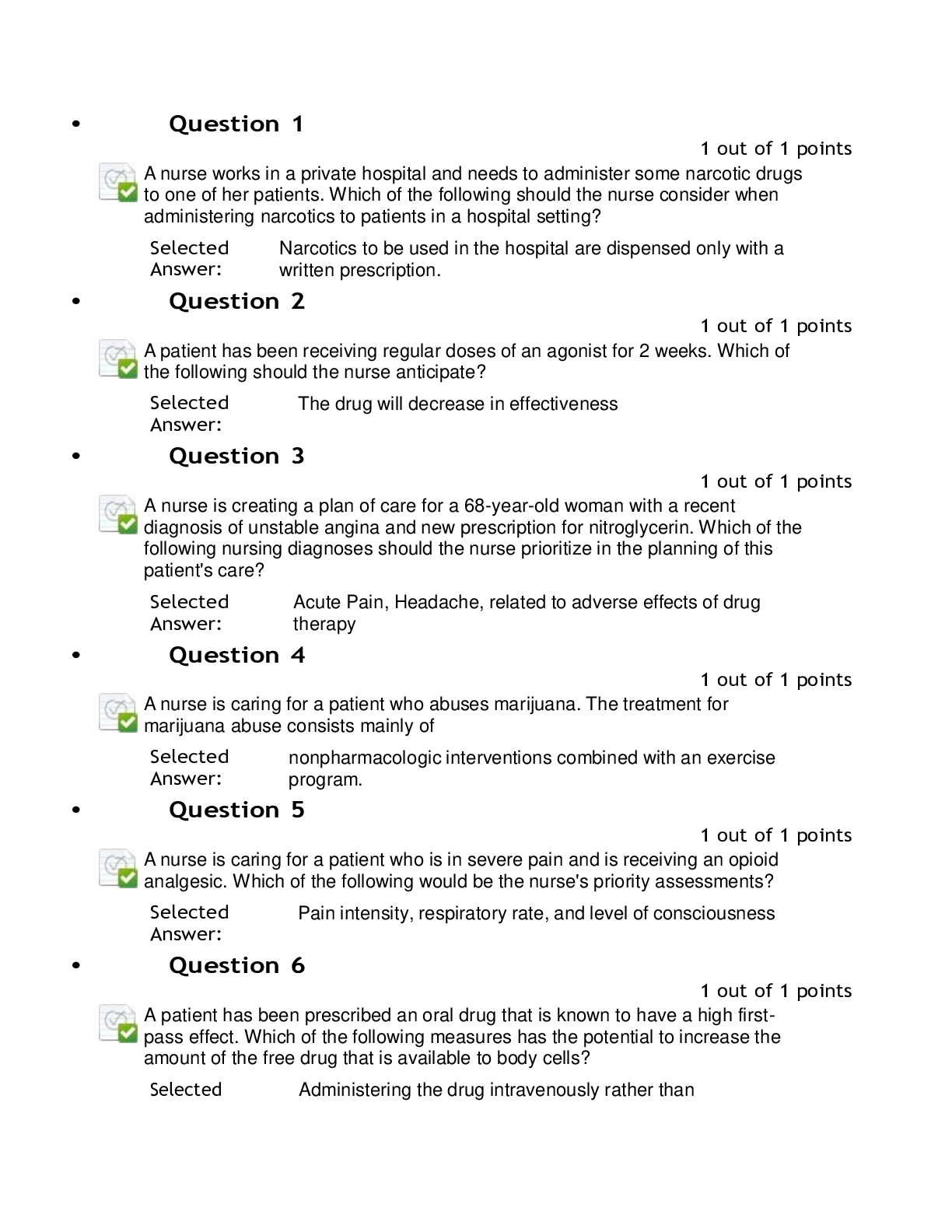
NURS 6521N ADVANCED PHARMACOLOGY FINAL EXAM WITH 100 QUESTION AND 100% CORRECT ANSWERS
• Question 1 1 out of 1 points A nurse works in a private hospital and needs to administer some narcotic drugs to one of her patients. Which of the following should the nurse consider...
By Excellentpass , Uploaded: Feb 02, 2022
$11
Pharmacology> EXAM > NURS 6521N ADVANCED PHARMACOLOGY FINAL EXAM WITH 100 QUESTIONS AND 100% CORRECT ANSWERS (All)

NURS 6521N ADVANCED PHARMACOLOGY FINAL EXAM WITH 100 QUESTIONS AND 100% CORRECT ANSWERS
•Question 1 1 out of 1 points A nurse works in a private hospital and needs to administer some narcotic drugs to one of her patients. Which of the following should the nurse consider when admi...
By Excellentpass , Uploaded: Feb 02, 2022
$12
Health Care> EXAM > SOCRA Practice Test | 100 Questions with 100% Correct Answers (All)
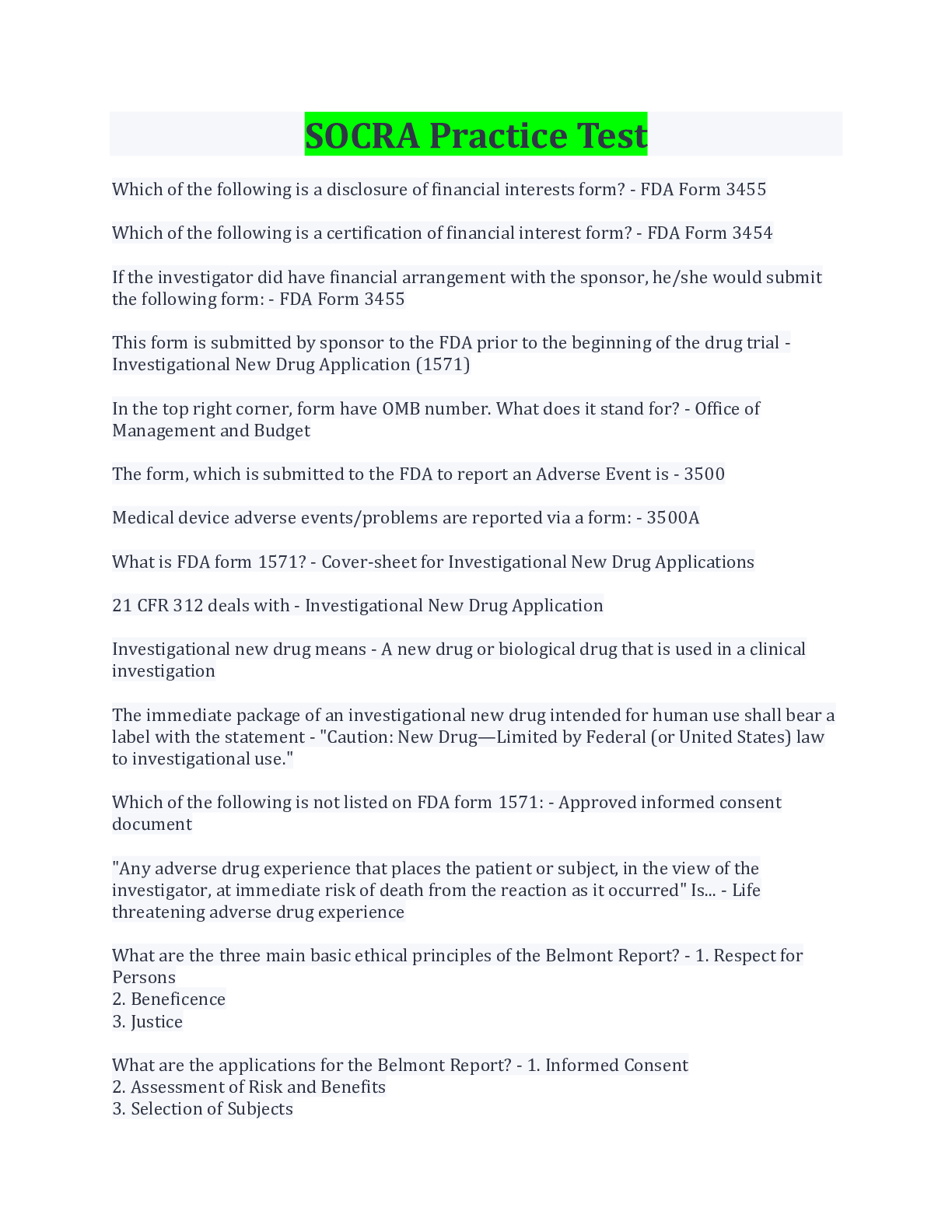
SOCRA Practice Test | 100 Questions with 100% Correct Answers
Which of the following is a disclosure of financial interests form? - ✔✔FDA Form 3455 Which of the following is a certification of financial interest form? - ✔✔FDA Form 3454 If the investigator did...
By Tessa , Uploaded: Aug 12, 2022
$12
Health Care> EXAM > Human Growth and Development CPCE 100 Questions with Verified Answers,100% CORRECT (All)

Human Growth and Development CPCE 100 Questions with Verified Answers,100% CORRECT
Human Growth and Development CPCE 100 Questions with Verified Answers Freud's stages are psychosexual while Erik Erikson's stages are - CORRECT ANSWER psychosocial. In Freudian theory instinc...
By Nolan19 , Uploaded: Aug 08, 2023
$11
*NURSING> EXAM > Pharmacology ATI Proctored Exam Detailed Answer Key _Cloned_Assessment 1. 2020. Contains 100 Q&A. Correct Answers Highlighted (All)
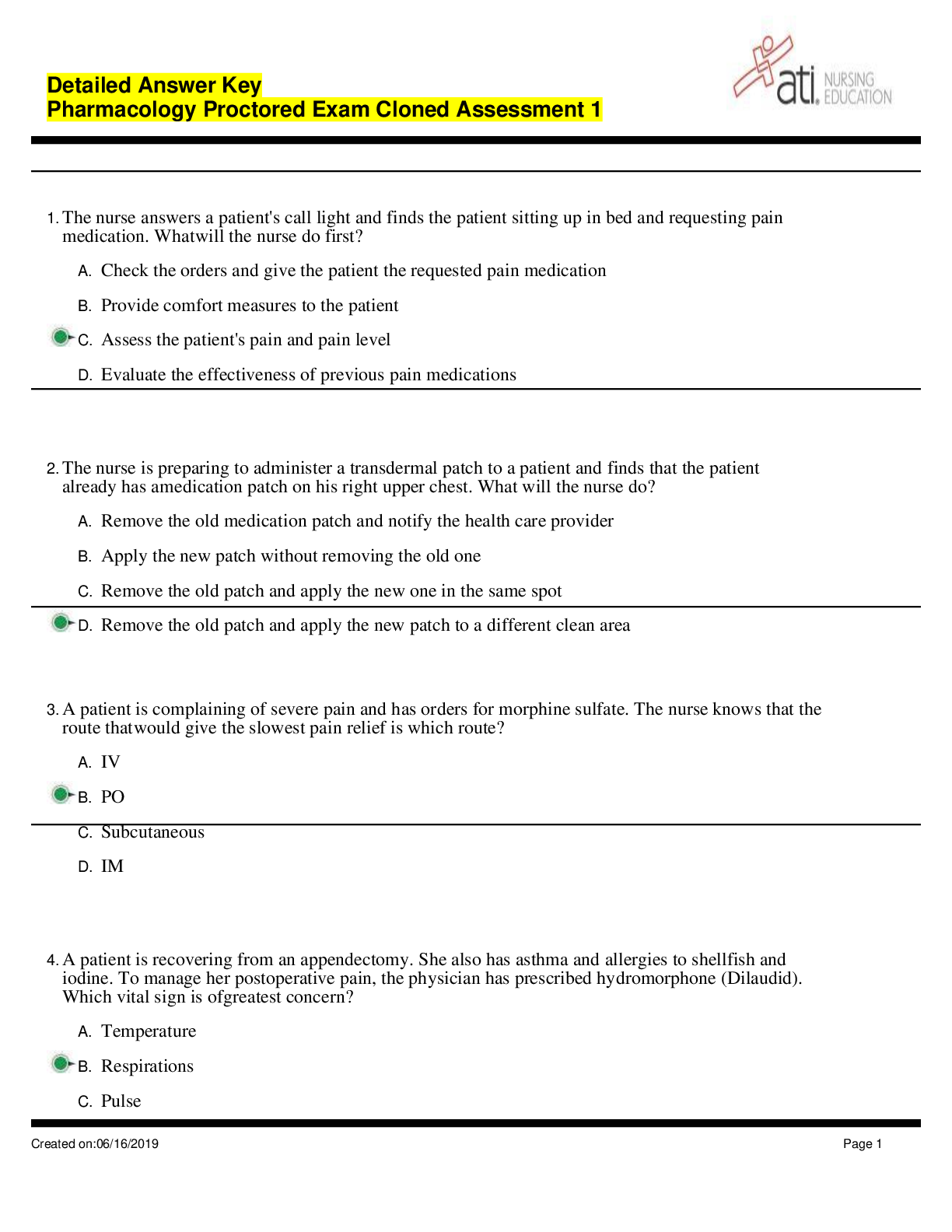
Pharmacology ATI Proctored Exam Detailed Answer Key _Cloned_Assessment 1. 2020. Contains 100 Q&A. Correct Answers Highlighted
1. The nurse answers a patient's call light and finds the patient sitting up in bed and requesting pain medication. What will the nurse do first? A. Check the orders and give the patient the requeste...
By destinyd , Uploaded: Jun 28, 2021
$14
*NURSING> EXAM > MEPAP 2 Final Exam 100 Questions with Correct Answers (All)

MEPAP 2 Final Exam 100 Questions with Correct Answers
MEPAP 2 Final Exam 100 Questions with Correct Answers 2023-2024
By Topmentor , Uploaded: Jun 08, 2023
$10.5
Document information
Connected school, study & course
About the document
Uploaded On
Jul 30, 2022
Number of pages
71
Written in
Additional information
This document has been written for:
Uploaded
Jul 30, 2022
Downloads
0
Views
73






